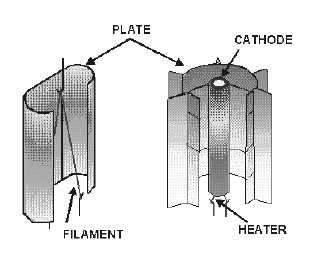1-10
Some schematics do not show heaters and heater connections. Heaters, of course, are still present in
the tubes, but their appearance in a schematic adds little to understanding the circuit. The heater is not
considered to be an active element. For example, a tube with an indirectly heated cathode and a plate is
still called a diode, even though it might seem that there are three elements in the tube.
Because indirectly heated cathodes are relatively large, they take longer to heat to electron-emitting
temperature. Once up to temperature, however, they do not respond to the small variations in heater
temperature caused by ac fluctuations. Because of the inherent advantages, most tubes in use today have
indirectly heated cathodes.
Q7.
Besides tungsten, what other materials are used for cathodes in vacuum tubes?
Q8.
What is the advantage of directly heated cathodes?
Plates
Edison’s plate was just that-a plate, a flat piece of metal. Plates are no longer flat but are designed in
many different shapes. Figure 1-8 shows two diodes, one with a directly heated cathode, the other with an
indirectly heated cathode. Each plate is cut away to show the internal position of elements and the plate
shapes.
Figure 1-8.—Cutaway view of plate construction.
Plates must be able to hold up under the stress of heat created by the flow of plate currents and the
closeness of hot cathodes. They need to be strong enough to withstand mechanical shocks produced by
vibration and handling.
Some typical materials used for electron tube plates are tungsten, molybdenum, graphite, nickel,
tantalum, and copper.
Tube Bases
The base shown in figure 1-9 has two functions. First, it serves as the mounting for tube elements.
Second, it serves as the terminal points for the electrical connections to the tube elements. This is
accomplished by molding or otherwise bringing pins (or prongs) through the base. The internal ends of
these pins are connected to tube elements. The pins themselves are male connections.

